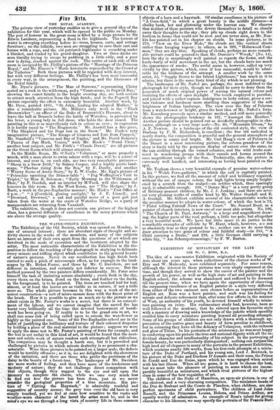put arts.
THE ROYAL ACADEMY.
The private view of yesterday enables us to give a general idea of the exhibition for this year, which will be opened to the public on Monday. The post of honour in the great room is filled by a large picture by Sir Edwin Landseer, representing a flood in the highlands. The torrent of water is sweeping everthing before it—trees, houses, carts, and cottage furniture; on the hillside, two men are struggling to save their cart and horses with a rope, and the old patriarch highlander is crouching under a blanket, and tended by his grand-daughter. Two or three ducks are seen timidly trying to escape by paddling in a little eddy, and a poor cow is dying, crushed against the rock. The centre of each side of this room is occupied by Mr. Phillip's picture of the "Marriage of the Princess Royal," and Mr. Elmore's " Marie Antoinette reproached by the Crowd at the Tuileries." Both these pictures will be regarded with deep interest, but with very different feelings. Mr. Phillip's has been most successful in every way, in the arrangement, the painting, and the likenesses of the Royal family.
Mr. Dyee's pictures, " The Man of Sorrows," representing Christ seated on a rock in the wilderness, and a " Coast-scene, in Pegwell Bay," showing the comet faintly in the bright evening sky, are both certain to attract much attention from the high finish; and in the Pegwell Bay picture especially the effect is extremely beautiful. Another work, by Mr. Dyce, painted 1851, "St. John, leading his adopted Mother," is also a remarkable picture. Mr. Millais's only work is the " Black Brunswicker "; an officer of the Duke of Brunswick's Hussars, about to leave the ball at Brussels before the battle of Waterloo, is prevented by his lover, a young lady in full dress, who holds the door closed. The painting in this is as marvellously rich in colour as ever ; in expression it is hardly equal to "The Huguenots." Mr. Ansdell has a fine piece, " The Shepherd and his Dogs lost in the Snow." Mr. Poole's very imaginative picture, "The FAcape of Glaucus and Ioni from Pompeii," Mr. Stanfield's "Vesuvius and Bay of Naples," and Mr. David Roberts's "Piazza of San Mark, Venice," with Mr. Hook's " Stand Clear," another boat subject, and Mr. Frith's " Claude Duval," are all pictures in the Great Room which will attract attention.
In the Middle Room, Mr. O'Neil's " Volunteer," or more properly a wreck, with a man about to swim ashore with a rope, will be a centre of interest, and near it, on each side, are two very remarkable pictures- " Sheep in a Snow Drift," by Sidney Cooper, and a highly poetic land- scape, "Phoebus rising from the Sea," by F. Denby, and another " Wintry Scene of Arctic Story," by E. W. Cooke. Mr. Egg's picture of "Petruchio upsetting the Dinner-table " ; "Peg Woffington's Visit to Triplet," by Miss R. Solomon ; "Early Morning in the Wilderness of Shur," by F. Goodall, and an interior by M'Faed, will also share the honours in this room. In the West Room, are " The Hedger," by J. Baett, a work in the pre-Raphaelite manner; Mr. Hick's "Post Office at 6 p.m. ; " " A 'Cornfield, glaring sunlight," by J. F. .Linnell ; and "Drowned, Drowned," a sad and painful scene of a poor girl just taken from the water at the stairs of Waterloo Bridge, as a party of masqueraders are returning from Vauxhall.
The exhitition, though it does not contain one picture of the highest class, has a general diffusion of excellence in the many pictures which are above the average quality.


























 Previous page
Previous page